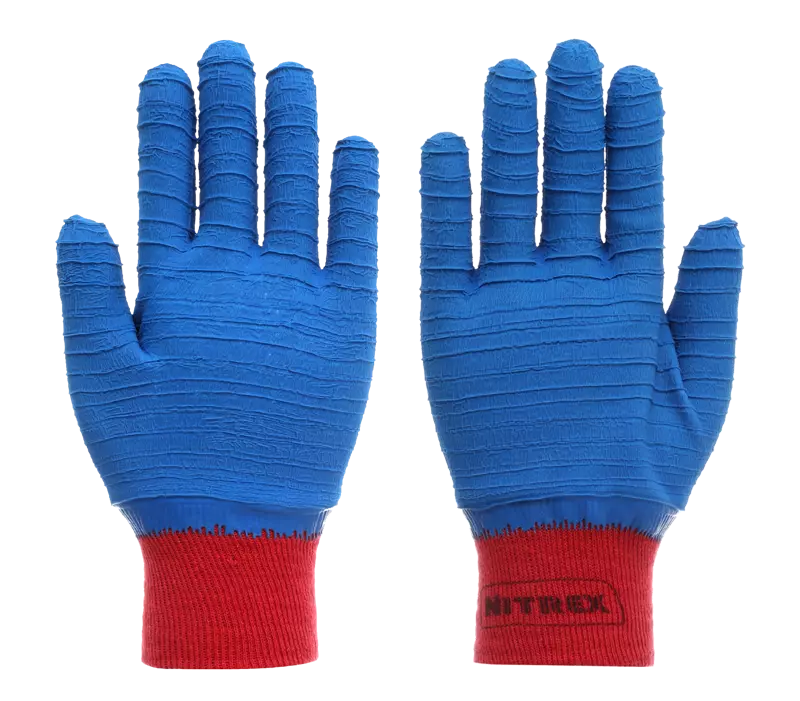
Nitrex Brushed cotton blue latex fully coated glove
Nitrex Brushed cotton blue latex fully coated glove
4.6 / 5


Features You'll Love

Palm Material · Latex
The material used on the palm side of the glove, affecting grip, durability, protection level, and comfort during use.
The material used on the palm side of the glove, affecting grip, durability, protection level, and comfort during use.
The material used on the palm side of the glove, affecting grip, durability, protection level, and comfort during use.
Nitrex
Brushed cotton blue latex fully coated glove, 10 pairs
Brushed cotton blue latex fully coated glove, 10 pairs
4.6 / 5
62,72 €
Price per 10 pairs
6,27 € / pair
Choose size
Free delivery
Features You'll Love

Palm Material · Latex
The material used on the palm side of the glove, affecting grip, durability, protection level, and comfort during use.
The material used on the palm side of the glove, affecting grip, durability, protection level, and comfort during use.
The material used on the palm side of the glove, affecting grip, durability, protection level, and comfort during use.
Product description
The product description has not been specified
The product description has not been specified
The product description has not been specified
The inner material that touches your skin, affecting comfort, warmth, moisture management, and overall fit of the glove.
The material used on the palm side of the glove, affecting grip, durability, protection level, and comfort during use.
Indicates which areas of the glove have protective or grip-enhancing coating applied, affecting durability, grip, and dexterity in different work tasks.
Determines how the glove secures around the wrist, affecting fit, protection from debris, and ease of putting gloves on and taking them off.
Flexible knit construction provides a comfortable, snug fit for enhanced dexterity and all-day comfort.
Full finger coverage offers complete protection and warmth, keeping your hands safe and comfortable.
The inner lining or coating that affects comfort, grip, insulation, and protection against chemicals or allergens.
Determines visibility, safety compliance, and how well dirt and wear are concealed during use in different work environments.
The material applied to glove surfaces to enhance grip, protection, and durability for specific work conditions and hazards.
- Cold Protective
- Cut Resistant
- Hand Protection
Protective gloves with the EN 388:2016 rating are tested for resistance against mechanical risks like abrasion, cuts, tears, punctures, and optional impact. This rating helps you quickly identify and choose gloves that offer the right level of protection for your hands during various tasks.
Test results
Provides minimal protection against cuts from a rotating blade under constant, low force.
Offers low cut protection for general work, such as packaging and light assembly.
Offers strong resistance against ripping, making the material durable against snags and tears.
Provides basic protection against punctures from blunt objects like splinters, not sharp points like needles.
Provides basic resistance against scraping and surface wear for low-risk tasks.
Products from companies with the EN ISO 9001:2015 rating are tested for the company's systems for consistently providing quality products and services and meeting customer needs. This means the company is committed to consistent quality, aiming to meet your needs and improve its offerings, leading to more reliable products and better customer experience.
Test results
This certification shows a commitment to quality and consistency. It ensures the company's processes are managed to deliver reliable, effective service and a better customer experience from start to finish.
Gloves and other hand protection with the EN 420 rating are tested for general safety, comfort, and harmlessness of materials. This ensures the product fits well, allows for good hand movement, and won't cause irritation or allergic reactions during use.
PPE stands for "personal protective equipment." PPE Category 2 refers to equipment that is more complex, and has a higher level of risk. Examples of PPE Category 2 include safety helmets, ear protection, and fall arrest equipment. In Europe, PPE Category 2 must meet certain safety standards set by the European Union, which means that it must be designed and manufactured to protect the user without causing harm. Companies that make or sell PPE must prove that it meets these standards. They also must have a quality management system in place and have to be audited regularly by a notified body.
Free delivery for all Unigloves products